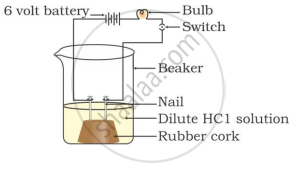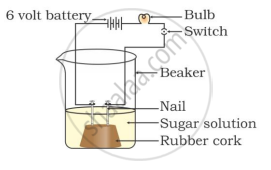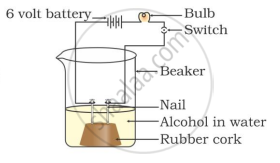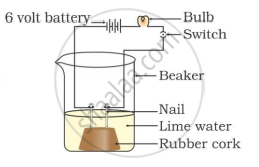Advertisements
Advertisements
Question
What is meant by strong bases and weak bases? Classify the following into strong bases and weak bases:
NH4OH, Ca(OH)2, NaOH, KOH, Mg(OH)2
Solution
Strong bases ionise completely in water, producing huge amounts of hydroxide ions (OH− ions). Generally, basic or alkali solutions of pH 8, 9 and 10 are considered weak bases or alkalis.
Weak bases ionise partially in water, producing less amounts of hydroxide ions (OH− ions).
Basic or alkali solutions of pH 11,12,13 and 14 are considered strong bases or alkalis.
Let us classify the given bases as strong or weak.
| Strong bases | Weak bases |
| Sodium hydroxide, NaOH Potassium hydroxide, KOH |
Ammonium hydroxide, NH4OH Calcium hydroxide, Ca(OH)2 Magnesium hydroxide, Mg(OH)2 |
APPEARS IN
RELATED QUESTIONS
While diluting an acid, why is it recommended that the acid should be added to water and not water to the acid?
Compounds such as alcohols and glucose also contain hydrogen but are not categorized as acids. Describe an activity to prove it.
Why does distilled water not conduct electricity, whereas rain water does?
Lime water turns milky when __________ gas is passed through it.
(a) H2
(b) CO
(c) CO2
(d) SO2
What colour do the following indicators turn when added to a base or alkali (such as sodium hydroxide)?
(a) methyl orange
Which gas is liberated when dilute hydrochloric acid reacts with sodium carbonate?
Vinay observed that the stain of curry on a white shirt becomes reddish-brown when soap is scrubbed on it, but it turns yellow again when the shirt is washed with plenty of water. What might be the reason for his observation?
- Soap is acidic in nature
- Soap is basic in nature
- Turmeric is a natural indicator which gives reddish tinge in bases
- Turmeric is a natural indicator which gives reddish tinge in acids
In which of the following setups would the bulb glow?
Identify the correct representation of reaction occurring during chloralkali process
A metal carbonate X on reacting with an acid gives a gas which when passed through a solution Y gives the carbonate back. On the other hand, a gas G that is obtained at anode during electrolysis of brine is passed on dry Y, It gives a compound Z, used for disinfecting drinking water. Identity X, Y, G and Z.




